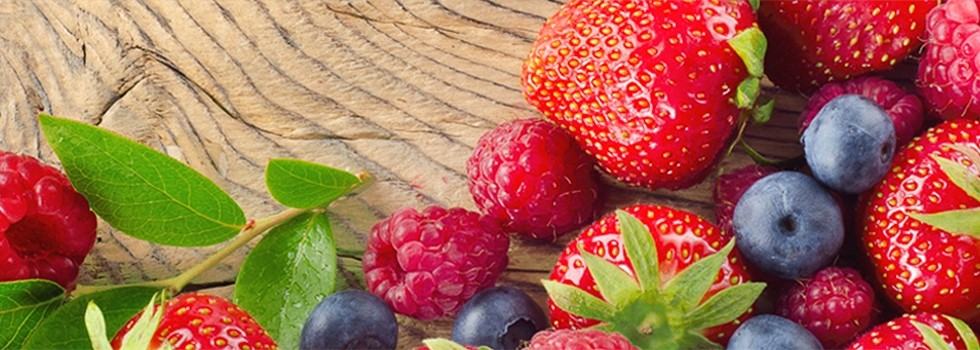Promotional Features
In Polyphenol-C, wide-spectrum berry polyphenols enhance the role of Non-GMO Vitamin-C
Vitamin-C and polyphenols in nature
It’s been known for centuries that eating fruits prevented scurvy, and in 1930 Albert Szent-Gyorzi was awarded the Nobel Prize for discovering the identity of the vitamin-C molecule. The name given to it, ‘ascorbic acid’ literally means ‘anti-scurvy’.
In nature vitamin-C is delivered primarily in the colorful packages of fruits and berries, such as blueberry, blackberry, raspberry, cranberry and strawberry. The deep purples, blues and reds of these fruits comprise their polyphenol and flavonoid components: anthocyanins, proanthocyanidins, bioflavonoids and others.
These compounds enhance the role of vitamin-C, and are the most abundant source of antioxidants in our diets. Like vitamin-C they play important roles as immune enhancers, in anti-inflammatory activity, cardiovascular support and many other health functions [1,2,3].
Polyphenols: the colors of health
Specific studies on the benefits of polyphenols include cardiovascular and antioxidant support for whole grape extract (this study was performed with ENI’s VinCare® extract) [4]. Additional published articles discuss the antioxidant mechanism of polyphenols, and the fact that diets rich in these compounds lowered the risks of many chronic inflammatory and degenerative diseases [4, 5].
A summary of the important health benefits of Polyphenol-C that have been discussed in scientific literature include [6,7,8]:
- Essential co-factor for important enzyme systems
- Essential for joints and connective tissues
- Antioxidant
- Immune support
- Supports healthy cardiovascular function
- Supports long-term cognitive and brain health
Polyphenol-C, a unique synthesis of natural ingredients
Polyphenol co-factors are generally not present in most vitamin-C products now available to the many consumers looking for more complete, premium health supplements. Polyphenol-C from ENI addresses this need by providing a wide spectrum of fruit and berry polyphenols with non-GMO vitamin-C.
The product is the result of years of work by the Ethical Naturals team into the sources and analysis of polyphenols. This work includes the development of VinCare, ENI’s patented whole grape extract. Vincare was the subject of a clinical trial published in The Journal of Functional Foods that demonstrated its’ beneficial role in improved antioxidant status and cardiovascular support [4].
Key ingredients in Polyphenol-C include:
- Non-GMO vitamin-C
- Vincare whole grape extract
- Cranberex, a highly concentrated cranberry extract containing cranberry’s unique A-Type proanthocyanidins.
- Blueberry, blackberry, raspberry and strawberry concentrates.
Cal Bewicke, CEO of ENI stated: ‘In the vitamin-C category, Polyphenol-C is an exciting and timely development. Today and for the future, people are looking for nature based immune and health support products. With Polyphenol-C we’ve made another step in bringing a more complete spectrum of nature’s ingredients into one supplement product.’
Each gram of Polyphenol-C contains: 600mg of Non-GMO vitamin-C and 400mg of fruit extracts and concentrates standardized to 25% polyphenols (100mg total polyphenols). ENI supplies this product in both bulk and encapsulated and packaged form.
------
References:
[1] Zafra-Stone, S. et al. (2007). Berry Anthocyanins as novel antioxidant in human health and disease prevention. Mol. Nutr. Food Res. 51, 675 – 683.
[2] Tsao, R. et al. (2010). Chemistry and Biochemistry of Dietary Polyphenols. Nutrients 2(12): 1231–1246.
[3] Basu, A., & Lyons, T. (2011). Strawberries, Blueberries, and Cranberries in the Metabolic Syndrome: Clinical Perspectives. J. Agric. Food Chem. 13, 60 (23), 5687-92. (https://www.ncbi.nlm.nih.gov/pubmed/22082311)
[4] Evans, M., et al. (2014). A randomized, double-blind, placebo-controlled, pilot study to evaluate the effect of whole grape extract on antioxidant status and lipid profile. Journal of Functional Foods. 7. 10.1016/j.jff.2013.12.017.
[5] Nassiri-Asl, M., et al. (2009). Review of the Pharmacological Effects of Vitis vinifera (Grape) and its Bioactive Compounds. Phototherapy Research 23, 1197–1204.
[6] Li, Y., & Schellhorn, H. E. (2007). New developments and novel therapeutic perspectives for vitamin C. J Nutr. 137, 2171-2184.
[7] Jacob, R.A., & Sotoudeh, G. (2002). Vitamin C function and status in chronic disease. Nutr Clin Care 5:66-74.
[8] Carr, A.C., & Frei, B. (1999). Toward a new recommended dietary allowance for vitamin C based on antioxidant and health effects in humans. Am J Clin Nutr 69:1086-107.





